- Calendar
- Online Ticket Sales
- Access
- JA
- EN
The Ryukyu Kingdom: A Treasure Chest of Beauty
July 18 to September 2, 2018
*There will be an exhibition change during the course of exhibition
*Download the list of changes in works on display
The list of changes in worksPDF
Section 1
Ryukyu Textiles
The Ryukyu Kingdom developed its distinctive culture through maritime trade. Ryukyu weaving and dyeing established while adopting techniques and materials from other East Asian nations. The beautiful result came to symbolize the Ryukyu Kingdom.
In the art of dyeing, Ryukyu is known for the bingata dyed garments worn primarily by members of the royal family and the aristocracy. The core technique in bingata dyeing is stencil resist dyeing, using paper stencils to produce the motifs that decorate these fabrics. Motifs from the Asian mainland, including the phoenix, dragon, and peony, are combined with characteristically Japanese designs such as pine, cherry, and plum trees, expressed in vivid colors.
Ryukyu textiles also use weaving techniques transmitted from China and Southeast Asia. Among the many types are kasuri (ikat) textiles, in which the yarns are resist-dyed before weaving to create geometric motifs, and hanaori, a floating weave brocade in which floating weft yarns create motifs. These techniques were used meticulously to create a variety of woven fabrics.
Garments for members of the royal family and the aristocracy were made of textiles held to rigorous standards. Design sketches for the woven and dyed motifs were created by artists at the Kaizuri-bugyosho (‘Shell-polishing Office’), a royal facility in the capital, Shuri, responsible for producing superb art and craft objects.
This section offers a view of what those splendid weaving and dyeing techniques created: the Ryukyu Kingdom’s beautiful world of color and design.
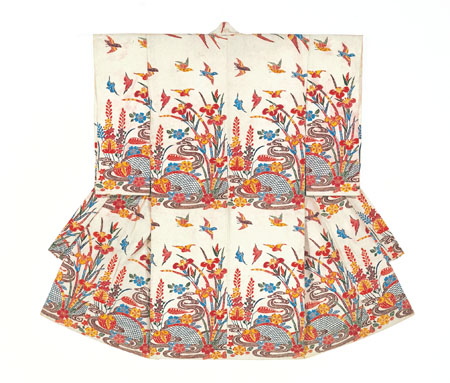
19th century
Okinawa Prefectural Museum and Art Museum
【To be shown between Jul. 18 and Aug. 6】
Section 2
Ryukyu Painting
Many paintings from the Ryukyu Kingdom were damaged or destroyed during World War II, leaving a full portrait of Ryukyuan achievements in painting shrouded in mystery. Surviving examples and prewar photographs, however, tell us of the superb artistic and technical mastery of the kingdom’s painters. This section primarily presents paintings from the Ryukyuan early modern period (1609–1879).
The royal palace in Shuri is said to have built, through its international network, a magnificent collection of Chinese and Japanese paintings. Ryukyu painting achieved its own distinctive development, stimulated by works from both China and Japan. Some Ryukyuan artists studied with Satsuma domain artists. Others are known to have been sent by the king to Fuzhou, China. Through their experiences, Ryukyu painting is thought to have had a particularly deep connection with the Fuzhou art world.
Most Ryukyuan painters were attached to the Kaizuri-bugyosho (‘Shellpolishing Office’) in Shuri, where they also worked on designs for textiles, lacquerware, and interior decoration. Some, however, were artists directly serving the royal court.
This section explores Ryukyu painting through masterworks by Yamaguchi (Kamiya) Soki (1672–1743), who was attached to the Kaizuri-bugyosho, and Zamami Yosho (1718–67), who was an artist by appointment to the royal court. It also introduces works on the theme of Ryukyuan manners and customs as well as paintings of the Ryukyuan mission, envoys from the Ryukyu Kingdom making their state visit to Edo, a subject that became extremely popular in Edo.
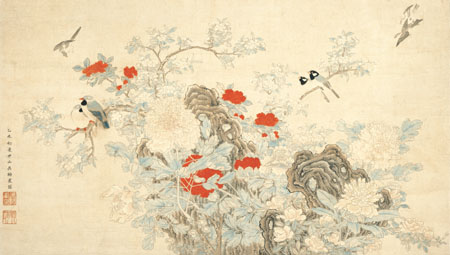
1715
The Museum Yamato Bunkakan
【To be shown between Aug. 8 and Sep. 2】
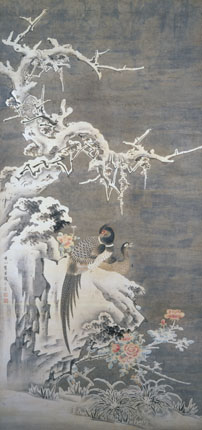
18th century
Okinawa Prefectural Museum and Art Museum
【To be shown between Jul. 18 and Aug. 6】
Section 3
The Arts of the Sho Dynasty
Sho En was crowned king of the Ryukyu Kingdom in the latter half of the fifteenth century. The first-generation Second Sho Dynasty king, he established a dynasty that continued to rule until 1879. The Ryukyu Kingdom achieved recognition by China under the tributary system. Early in the seventeenth century, it was invaded by the Satsuma domain and incorporated into the Japanese shogunate and domain system. Nonetheless, it continued to engage in tribute trade with China and to govern itself as a de facto independent kingdom under a system of dual sovereignty. The royal capital, Shuri, became the locus of a uniquely Ryukyuan culture that brought together the arts of Asia, and Shuri Castle was filled with treasures from China and many other lands.
After the Meiji government was established in 1868, Japan sought to end the system of dual sovereignty and claim the Ryukyu Islands as its territory. With the Ryukyuan Settlement of 1879, the nineteenth head of the Sho family, Sho Tai, was deposed, what had been the Ryukyu Kingdom became Okinawa Prefecture, and part of the royal family’s many possessions were moved to Tokyo (where the Sho, newly designated as members of the Japanese peerage, established a residence). During World War II, Okinawa suffered colossal damage to objects representing its cultural heritage, but some treasures of the royal family in Tokyo have survived. In 2006, works of art, craft objects, documents, records, and other materials handed down by the Sho family were collectively designated National Treasures under the title “Ryukyu Sho Dynasty Related Artifacts.”
This section introduces the gemlike collection included in the Ryukyu Sho Dynasty Related Artifacts. It also includes rare works concerning the royal family and Shuri Castle to enhance the visitor’s experience.
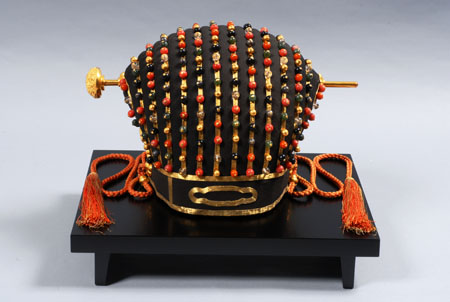
18th–19th century
Naha City Museum of History
【To be shown between Aug. 22 and Sep. 2】
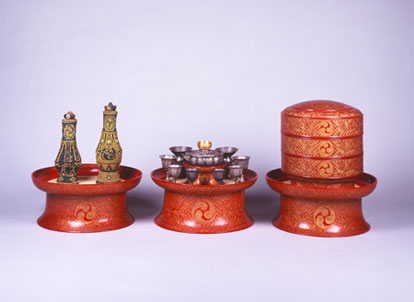
15th–18th century
Naha City Museum of History
【To be shown over an entire period】
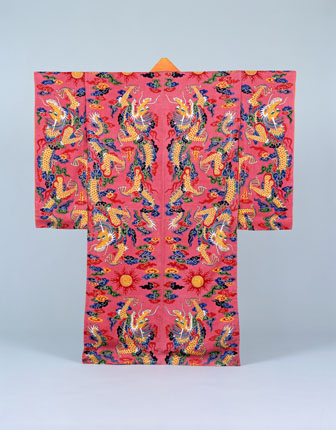
18th–19th century
Naha City Museum of History
【To be shown between Jul. 18 and Jul. 30】
Section 4
Scintillating Ryukyu Lacquerware
The art of lacquerware developed in the Ryukyu Kingdom through its trade with China and other neighboring countries. When Ryukyuan lacquer production began is unclear. Among the oldest examples of Ryukyu gold inlay lacquerware for which a date can be inferred, however, are the Black lacquer round outer box with chrysanthemum flower, bird, and insect motifs in gold inlay and the Green lacquer round inner box with phoenix and cloud motifs in gold inlay, in which a priestess on the Ryukyu island of Kumejima made an offering of sacred jewels bestowed by the king in 1500.
Lacquerware was an important export from the Ryukyu Kingdom, as part of its flourishing international trade. The Kaizuri-bugyosho (‘Shell-polishing Office’), a royal government facility in the capital, Shuri, was responsible for managing the production of the beautiful works used as gifts to the emperor of China and the shogun and daimyo in Japan. Painters at the Kaizuri-bugyosho attached to that facility were engaged in designing the lacquerware. Chinese motifs such as auspicious designs and bird-and-flower and landscape designs were skillfully rendered using exquisite techniques such as mother-of-pearl inlay, gold inlay, and mitsuda-e, a form of oil painting.
Please savor the lacquerware created in the Ryukyu Kingdom in all its variety as you explore its elegance.
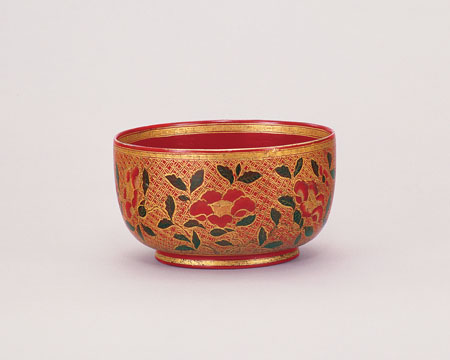
16th–17th century
Suntory Museum of Art
【To be shown over an entire period】
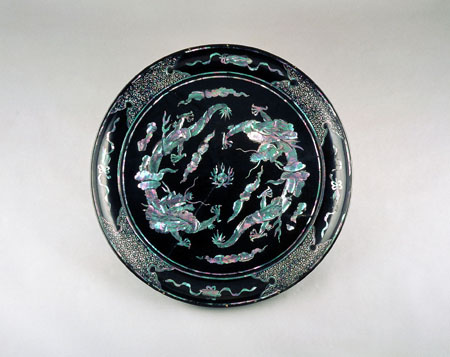
18th–19th century
Urasoe Art Museum
【To be shown over an entire period】
Epilogue
Memories of the Ryukyu Kingdom
Kamakura Yoshitaro (1898–1983) was a leader in research on Okinawan culture. He who left us photographs from before World War II communicating the culture of the Ryukyu Kingdom period, having photographed Shuri Castle and other buildings as well as works of art and craft objects. After the war, he was designated as the Holder of an Intangible Cultural Property (“Living National Treasure”) for stencil resist dyeing. In 1972, the Suntory Museum of Art and the Ryukyu Governmental Museum held Special Exhibition: Okinawa 50 Years Ago: Seeing Lost Cultural Assets Through Photographs, which featured his photographs. We are delighted to conclude this exhibition by introducing many of his photographs and detailed research notes, invaluable reference materials that communicate memories of the lost world of the Ryukyu Kingdom.
*Unauthorized reproduction or use of texts or images from this site is prohibited.
2025 January
- Exhibition
- Closed
- Tea Ceremony
- Mon
- Tue
- Wed
- Thu
- Fri
- Sat
- Sun
- 1
- 2
- 3
- 4
- 5
- 6
- 7
- 8
- 9
- 10
- 11
- 12
- 13
- 14
- 15
- 16
- 17
- 18
- 19
- 20
- 21
- 22
- 23
- 24
- 25
- 26
- 27
- 28
- 29
- 30
- 31
2025 February
- Exhibition
- Closed
- Tea Ceremony
- Mon
- Tue
- Wed
- Thu
- Fri
- Sat
- Sun
- 1
- 2
- 3
- 4
- 5
- 6
- 7
- 8
- 9
- 10
- 11
- 12
- 13
- 14
- 15
- 16
- 17
- 18
- 19
- 20
- 21
- 22
- 23
- 24
- 25
- 26
- 27
- 28
2025 March
- Exhibition
- Closed
- Tea Ceremony
- Mon
- Tue
- Wed
- Thu
- Fri
- Sat
- Sun
- 1
- 2
- 3
- 4
- 5
- 6
- 7
- 8
- 9
- 10
- 11
- 12
- 13
- 14
- 15
- 16
- 17
- 18
- 19
- 20
- 21
- 22
- 23
- 24
- 25
- 26
- 27
- 28
- 29
- 30
- 31
2025 April
- Exhibition
- Closed
- Tea Ceremony
- Mon
- Tue
- Wed
- Thu
- Fri
- Sat
- Sun
- 1
- 2
- 3
- 4
- 5
- 6
- 7
- 8
- 9
- 10
- 11
- 12
- 13
- 14
- 15
- 16
- 17
- 18
- 19
- 20
- 21
- 22
- 23
- 24
- 25
- 26
- 27
- 28
- 29
- 30
2025 May
- Exhibition
- Closed
- Tea Ceremony
- Mon
- Tue
- Wed
- Thu
- Fri
- Sat
- Sun
- 1
- 2
- 3
- 4
- 5
- 6
- 7
- 8
- 9
- 10
- 11
- 12
- 13
- 14
- 15
- 16
- 17
- 18
- 19
- 20
- 21
- 22
- 23
- 24
- 25
- 26
- 27
- 28
- 29
- 30
- 31
2025 June
- Exhibition
- Closed
- Tea Ceremony
- Mon
- Tue
- Wed
- Thu
- Fri
- Sat
- Sun
- 1
- 2
- 3
- 4
- 5
- 6
- 7
- 8
- 9
- 10
- 11
- 12
- 13
- 14
- 15
- 16
- 17
- 18
- 19
- 20
- 21
- 22
- 23
- 24
- 25
- 26
- 27
- 28
- 29
- 30
2025 July
- Exhibition
- Closed
- Tea Ceremony
- Mon
- Tue
- Wed
- Thu
- Fri
- Sat
- Sun
- 1
- 2
- 3
- 4
- 5
- 6
- 7
- 8
- 9
- 10
- 11
- 12
- 13
- 14
- 15
- 16
- 17
- 18
- 19
- 20
- 21
- 22
- 23
- 24
- 25
- 26
- 27
- 28
- 29
- 30
- 31
2025 August
- Exhibition
- Closed
- Tea Ceremony
- Mon
- Tue
- Wed
- Thu
- Fri
- Sat
- Sun
- 1
- 2
- 3
- 4
- 5
- 6
- 7
- 8
- 9
- 10
- 11
- 12
- 13
- 14
- 15
- 16
- 17
- 18
- 19
- 20
- 21
- 22
- 23
- 24
- 25
- 26
- 27
- 28
- 29
- 30
- 31
2025 September
- Exhibition
- Closed
- Tea Ceremony
- Mon
- Tue
- Wed
- Thu
- Fri
- Sat
- Sun
- 1
- 2
- 3
- 4
- 5
- 6
- 7
- 8
- 9
- 10
- 11
- 12
- 13
- 14
- 15
- 16
- 17
- 18
- 19
- 20
- 21
- 22
- 23
- 24
- 25
- 26
- 27
- 28
- 29
- 30
2025 October
- Exhibition
- Closed
- Tea Ceremony
- Mon
- Tue
- Wed
- Thu
- Fri
- Sat
- Sun
- 1
- 2
- 3
- 4
- 5
- 6
- 7
- 8
- 9
- 10
- 11
- 12
- 13
- 14
- 15
- 16
- 17
- 18
- 19
- 20
- 21
- 22
- 23
- 24
- 25
- 26
- 27
- 28
- 29
- 30
- 31
2025 November
- Exhibition
- Closed
- Tea Ceremony
- Mon
- Tue
- Wed
- Thu
- Fri
- Sat
- Sun
- 1
- 2
- 3
- 4
- 5
- 6
- 7
- 8
- 9
- 10
- 11
- 12
- 13
- 14
- 15
- 16
- 17
- 18
- 19
- 20
- 21
- 22
- 23
- 24
- 25
- 26
- 27
- 28
- 29
- 30
2025 December
- Exhibition
- Closed
- Tea Ceremony
- Mon
- Tue
- Wed
- Thu
- Fri
- Sat
- Sun
- 1
- 2
- 3
- 4
- 5
- 6
- 7
- 8
- 9
- 10
- 11
- 12
- 13
- 14
- 15
- 16
- 17
- 18
- 19
- 20
- 21
- 22
- 23
- 24
- 25
- 26
- 27
- 28
- 29
- 30
- 31
2026 January
- Exhibition
- Closed
- Tea Ceremony
- Mon
- Tue
- Wed
- Thu
- Fri
- Sat
- Sun
- 1
- 2
- 3
- 4
- 5
- 6
- 7
- 8
- 9
- 10
- 11
- 12
- 13
- 14
- 15
- 16
- 17
- 18
- 19
- 20
- 21
- 22
- 23
- 24
- 25
- 26
- 27
- 28
- 29
- 30
- 31
2026 February
- Exhibition
- Closed
- Mon
- Tue
- Wed
- Thu
- Fri
- Sat
- Sun
- 1
- 2
- 3
- 4
- 5
- 6
- 7
- 8
- 9
- 10
- 11
- 12
- 13
- 14
- 15
- 16
- 17
- 18
- 19
- 20
- 21
- 22
- 23
- 24
- 25
- 26
- 27
- 28
2026 March
- Exhibition
- Closed
- Mon
- Tue
- Wed
- Thu
- Fri
- Sat
- Sun
- 1
- 2
- 3
- 4
- 5
- 6
- 7
- 8
- 9
- 10
- 11
- 12
- 13
- 14
- 15
- 16
- 17
- 18
- 19
- 20
- 21
- 22
- 23
- 24
- 25
- 26
- 27
- 28
- 29
- 30
- 31
2026 April
- Exhibition
- Closed
- Mon
- Tue
- Wed
- Thu
- Fri
- Sat
- Sun
- 1
- 2
- 3
- 4
- 5
- 6
- 7
- 8
- 9
- 10
- 11
- 12
- 13
- 14
- 15
- 16
- 17
- 18
- 19
- 20
- 21
- 22
- 23
- 24
- 25
- 26
- 27
- 28
- 29
- 30
2026 May
- Exhibition
- Closed
- Mon
- Tue
- Wed
- Thu
- Fri
- Sat
- Sun
- 1
- 2
- 3
- 4
- 5
- 6
- 7
- 8
- 9
- 10
- 11
- 12
- 13
- 14
- 15
- 16
- 17
- 18
- 19
- 20
- 21
- 22
- 23
- 24
- 25
- 26
- 27
- 28
- 29
- 30
- 31
2026 June
- Exhibition
- Closed
- Mon
- Tue
- Wed
- Thu
- Fri
- Sat
- Sun
- 1
- 2
- 3
- 4
- 5
- 6
- 7
- 8
- 9
- 10
- 11
- 12
- 13
- 14
- 15
- 16
- 17
- 18
- 19
- 20
- 21
- 22
- 23
- 24
- 25
- 26
- 27
- 28
- 29
- 30
2026 July
- Exhibition
- Closed
- Mon
- Tue
- Wed
- Thu
- Fri
- Sat
- Sun
- 1
- 2
- 3
- 4
- 5
- 6
- 7
- 8
- 9
- 10
- 11
- 12
- 13
- 14
- 15
- 16
- 17
- 18
- 19
- 20
- 21
- 22
- 23
- 24
- 25
- 26
- 27
- 28
- 29
- 30
- 31
2026 August
- Exhibition
- Closed
- Mon
- Tue
- Wed
- Thu
- Fri
- Sat
- Sun
- 1
- 2
- 3
- 4
- 5
- 6
- 7
- 8
- 9
- 10
- 11
- 12
- 13
- 14
- 15
- 16
- 17
- 18
- 19
- 20
- 21
- 22
- 23
- 24
- 25
- 26
- 27
- 28
- 29
- 30
- 31
2026 September
- Exhibition
- Closed
- Mon
- Tue
- Wed
- Thu
- Fri
- Sat
- Sun
- 1
- 2
- 3
- 4
- 5
- 6
- 7
- 8
- 9
- 10
- 11
- 12
- 13
- 14
- 15
- 16
- 17
- 18
- 19
- 20
- 21
- 22
- 23
- 24
- 25
- 26
- 27
- 28
- 29
- 30
2026 October
- Exhibition
- Closed
- Mon
- Tue
- Wed
- Thu
- Fri
- Sat
- Sun
- 1
- 2
- 3
- 4
- 5
- 6
- 7
- 8
- 9
- 10
- 11
- 12
- 13
- 14
- 15
- 16
- 17
- 18
- 19
- 20
- 21
- 22
- 23
- 24
- 25
- 26
- 27
- 28
- 29
- 30
- 31
2026 November
- Exhibition
- Closed
- Mon
- Tue
- Wed
- Thu
- Fri
- Sat
- Sun
- 1
- 2
- 3
- 4
- 5
- 6
- 7
- 8
- 9
- 10
- 11
- 12
- 13
- 14
- 15
- 16
- 17
- 18
- 19
- 20
- 21
- 22
- 23
- 24
- 25
- 26
- 27
- 28
- 29
- 30
2026 December
- Exhibition
- Closed
- Mon
- Tue
- Wed
- Thu
- Fri
- Sat
- Sun
- 1
- 2
- 3
- 4
- 5
- 6
- 7
- 8
- 9
- 10
- 11
- 12
- 13
- 14
- 15
- 16
- 17
- 18
- 19
- 20
- 21
- 22
- 23
- 24
- 25
- 26
- 27
- 28
- 29
- 30
- 31
